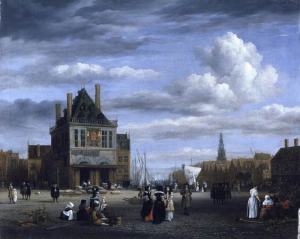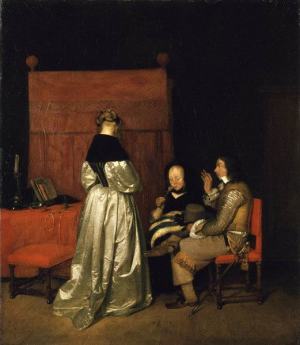|
 ...
Per la prima volta in
Italia sarà finalmente possibile ammirare una ricca
selezione di opere appartenenti alla più importante
collezione al mondo di dipinti fiamminghi e olandesi del
XVII secolo, quella della Gemäldegalerie di Berlino,
composta da capolavori quali Il cambiavalute di
Rembrandt a la Ragazza col filo di perle di Vermeer. ...
Per la prima volta in
Italia sarà finalmente possibile ammirare una ricca
selezione di opere appartenenti alla più importante
collezione al mondo di dipinti fiamminghi e olandesi del
XVII secolo, quella della Gemäldegalerie di Berlino,
composta da capolavori quali Il cambiavalute di
Rembrandt a la Ragazza col filo di perle di Vermeer.
Attraverso i 55 capolavori esposti i visitatori avranno
l'opportunità di conoscere l'arte e la cultura delle
Fiandre e dell'Olanda durante il loro 'Secolo d'Oro'.
Il percorso evidenzia
l'alto grado di sviluppo raggiunto dalla cultura
pittorica dell'arte olandese in un periodo storico
caratterizzato da cambiamenti significativi a livello
culturale, politico, economico e religioso.
Allo stesso tempo
chiarisce quanto radicate e profonde fossero, negli
stessi anni, le differenze tra l'Italia e i Paesi Bassi
nell'estetica e nella realtà sociale, pur esistendo dei
parallelismi dovuti all'influenza che l'arte italiana
ebbe in artisti come Rubens o Van Dyck.
 Tra i capolavori in mostra al Museo del Corso: Il
cambiavalute e il ritratto di Hendrickje Stoffels di
Rembrandt; L'uomo con l'elmo d'oro, considerato a lungo
la quintessenza della sua arte ritrattistica, una sorta
di equivalente della Gioconda, poi attribuito a un
anonimo pittore della sua cerchia; La sacra famiglia di
Aert de Gelder, mirabile esempio della trasposizione di
temi sacri nell'arte olandese; Ragazzo che canta, con
flauto di Frans Hals, un vivace ritratto di un garzone
che ha appena smesso di suonare, sorpreso da qualcosa
che rimane invisibile agli occhi degli spettatori;
L'ammonimento paterno di Gerard ter Borch, esempio di
grande calibro della pittura di genere olandese; la
Ragazza col filo di perle di Jan Vermeer, capolavoro
assoluto di un artista unico, che ha prodotto solo 36
opere, noto per la luminosità e la limpidezza della sua
pittura; La Madre e La pesatrice d'oro, mirabili tele di
Pieter de Hooch, insieme a Vermeer il più
rappresentativo artista di interni; Paesaggio con
l'impiccato di Rubens, una tela di rara bellezza di
pittura paesaggistica con la sua atmosfera pesante e
inquietante; Tommaso di Carignano Principe di Savoia e
Ritratto di gentildonna genovese di Anton van Dyck,
discepolo preferito di Rubens e pittore amato e
ricercato dalle grandi famiglie notabili di tutta Europa
per la sua altissima abilità di ritrattista. Tra gli
altri, saranno esposte anche opere di Cornelis Bega,
Gerard Dou, Gabriel Metsu, Salomon Jacobsz van Ruisdael
e Jan Stehen. Tra i capolavori in mostra al Museo del Corso: Il
cambiavalute e il ritratto di Hendrickje Stoffels di
Rembrandt; L'uomo con l'elmo d'oro, considerato a lungo
la quintessenza della sua arte ritrattistica, una sorta
di equivalente della Gioconda, poi attribuito a un
anonimo pittore della sua cerchia; La sacra famiglia di
Aert de Gelder, mirabile esempio della trasposizione di
temi sacri nell'arte olandese; Ragazzo che canta, con
flauto di Frans Hals, un vivace ritratto di un garzone
che ha appena smesso di suonare, sorpreso da qualcosa
che rimane invisibile agli occhi degli spettatori;
L'ammonimento paterno di Gerard ter Borch, esempio di
grande calibro della pittura di genere olandese; la
Ragazza col filo di perle di Jan Vermeer, capolavoro
assoluto di un artista unico, che ha prodotto solo 36
opere, noto per la luminosità e la limpidezza della sua
pittura; La Madre e La pesatrice d'oro, mirabili tele di
Pieter de Hooch, insieme a Vermeer il più
rappresentativo artista di interni; Paesaggio con
l'impiccato di Rubens, una tela di rara bellezza di
pittura paesaggistica con la sua atmosfera pesante e
inquietante; Tommaso di Carignano Principe di Savoia e
Ritratto di gentildonna genovese di Anton van Dyck,
discepolo preferito di Rubens e pittore amato e
ricercato dalle grandi famiglie notabili di tutta Europa
per la sua altissima abilità di ritrattista. Tra gli
altri, saranno esposte anche opere di Cornelis Bega,
Gerard Dou, Gabriel Metsu, Salomon Jacobsz van Ruisdael
e Jan Stehen.
L'esposizione è a cura di Berndt Lindemann, direttore
della Gemäldegalerie, ed è realizzata con la
collaborazione di MondoMostre.
© MondoMostre
 The Fondazione Roma brings the artists of the
Netherlands’ Golden Century to Rome in an exhibition at
the Museo del Corso. The Fondazione Roma brings the artists of the
Netherlands’ Golden Century to Rome in an exhibition at
the Museo del Corso.
From November 11, 2008 to February 15, 2009, the
Fondazione Roma, headed by Prof. Emmanuele Francesco
Maria Emanuele, will present the exhibition From
Rembrandt to Vermeer.
Civil Values in 17th‐century Flemish and Dutch Painting
at its Museo del Corso.
Representing the “Golden Century” of Flemish and Dutch
art, the exhibition focuses on the development of the
genre of the domestic interior, which was dedicated to
family life and reflected the innovative social context
and civil values of Holland in the 17th century.
For the first time in Italy, it will finally be possible
to admire a large selection of works belonging the
world’s most important collection of 17th‐century Dutch
and Flemish paintings: that of Berlin’s Gemäldegalerie,
which includes masterpieces such as Rembrandt’s The
Money Changer and Vermeer’s Woman with a Pearl Necklace.
“The exhibition is the result of the cooperation between
the Fondazione Roma and the Gemäldegalerie following the
Foundation’s decision to contribute to the project of
taking the Sebastiano del Piombo exhibition presented at
Palazzo Venezia in Rome to Berlin,” says Prof. Emanuele.
“The works that will be exhibited at the Museo del Corso
come, in effect, from the Gemäldegalerie. From the point
of view of art history, the exhibition is one of the
most important that the Foundation has organized in the
last few years. It aims to offer visitors a group of
works that is highly representative of a genre rarely
seen in Italian museums and, in accordance with the
Foundation’s philosophy, to highlight art as an
instrument of knowledge and dialogue capable of laying
the foundation for a fair and open discussion with the
cultures of other peoples.”
The 55 masterpieces on display will enable visitors to
learn about the art and culture of Flanders and Holland
during their “Golden Century”. The exhibition reflects
the high degree of development achieved by the pictorial
culture of Dutch painting in a historical period
characterized by significant changes at the cultural,
political, economic, and religious levels. At the same
time, it shows how radical and deep the esthetic and
social differences between Italy and the Netherlands
were at the time, even though there were parallels
deriving from the influence that Italian art had on
artists like Rubens and Van Dyck.
 The historical context The historical context
In the second half of the 16th century, Dutch artists
found themselves in a new situation. The political split
between the northern provinces of the Netherlands and
the southern ones, which remained loyal to the Spanish
crown, and the establishment in 1588 of the Republic of
the United Provinces deprived the Provinces of the North
of a court center and at the same time brought to an end
the large commissions for churches. The increasing
dissemination of the principles of the Protestant
Reformation inevitably changed the artistic production
of the period.
Painters no longer had certain commissions and earnings,
and thus had to “place” their works on the market just
like any other goods. The split between artists and
patrons was to change the entire structure of the art
world, where paintings were no longer bound to power or
religion, but would have to satisfy popular taste and be
a direct expression of it. The artists’ customers now
belonged to the new middle class, which was connected
with the rapid Dutch commercial and economic growth.
Like the European nobility, they discovered that
paintings are a symbol of power and wealth, emblems to
collect and to show off in their homes, of which they
often requested a “portrait”. For this new class, the
importance of owning works of art is shown by the
presence within the picture of another painting or, in
some cases, of the same one.
A pictorial genre
This was the historical context out of which emerged the
painting of interiors and group portraits, in which the
subjects are depicted doing everyday things, in a
setting which for the first time was that of intimate
family life and presented the viewer with a detailed
representation of Dutch society in the 17th century.
Everyday scenes and objects referring to hidden meanings
and moral admonitions acquired artistic dignity in such
paintings.
Very fashionable were also portraits, which depicted
mainly the new middle class, paintings representing
historical subjects, and still lives. Artists began to
execute landscapes, in which, once figurative subjects
were eliminated, the background was to become more and
more important. In order to facilitate their
transportation and sale, paintings soon became small‐sized.
That art is the “mirror of the times” was exemplified by
the work of many artists, including Vermeer himself, who
used recent scientific discoveries, such as the camera
obscura, to reproduce scenes more precisely than was
possible with the naked human eye.
The masterpieces on display
The exhibition at the Museo del Corso includes
masterpieces such as: The Money Changer and the portrait
of Hendrickje Stoffels by Rembrandt; The Man with the
Golden Helmet, which was long considered the
quintessence of his portraiture and is now attributed to
an anonymous painter of his circle; The Holy Family by
Aert de Gelder, a marvelous example of the transposition
of holy subjects in Dutch art; Singing Boy with a Flute
by Frans Hals, a lively portrait of a boy who has just
stopped playing and is surprised by something that the
eyes of the viewer cannot see; A Paternal Admonishment
by Gerard ter Borch, a superior example of Dutch genre
painting; the Woman with a Pearl Necklace by Jan Vermeer,
an absolute masterpiece by a unique artist, who produced
only 36 works and is famous for the luminosity and
limpidity of his painting; A Mother and A Woman
Weighing Gold, marvelous paintings by Pieter de Hooch,
along with Vermeer the most representative painter of
interiors; Landscape with a Hung Man by Rubens, a
landscape painting of rare beauty, with its oppressive
and disquieting atmosphere; Tommaso di Carignano, Prince
of Savoia and Portrait of A Genoese Noblewoman by Anton
van Dyck, Rubens’s favorite disciple and a painter who
was loved and sought after by great families all over
Europe because of his very great skill in portraiture.
The exhibition also includes works by, among others,
Cornelis Bega, Gerard Dou, Gabriel Metsu, Salomon
Jacobsz van Ruisdael, and Jan Stehen.
Bernd Lindemann, Director of the Gemäldegalerie, is the
curator of the exhibition, which is organized in
cooperation with MondoMostre.
|

